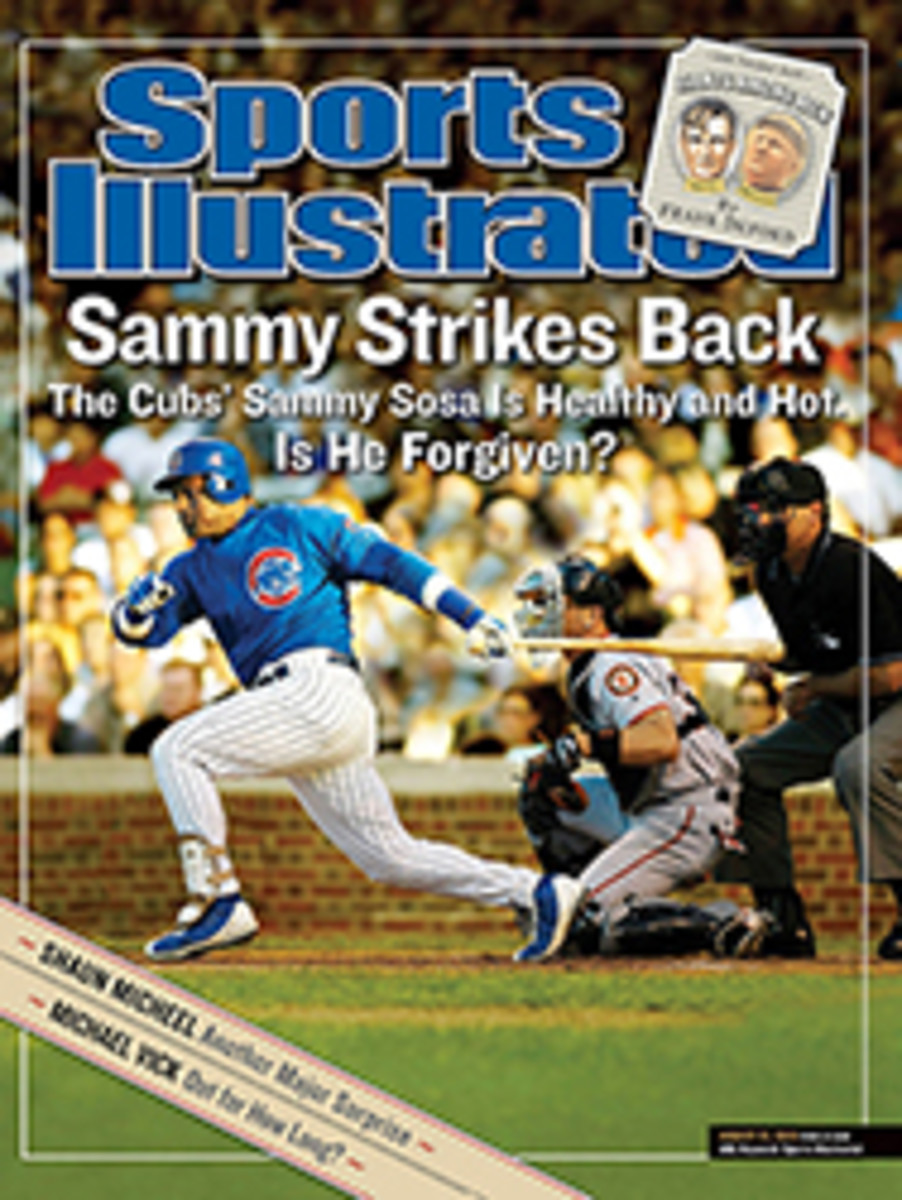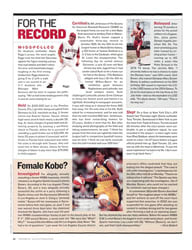
Off Track To make it a dream course for a future U.S. Open, Oak Hill was turned into every player's nightmare
Rich Beem, David Toms and Tiger Woods, the last three winners of
the PGA Championship, were grouped in a kingly threesome during
the opening round of last week's PGA at Oak Hill, in Rochester,
N.Y. It seemed like a dream trio, but much like the championship
itself, it turned out to be a disaster. The three shot a combined
21 over par, with Woods the low hero with a four-over 74. "We
weren't a whole lot of fun to watch," Toms admitted. ¶ The same
could be said for the PGA, which was filled with scenes like the
one last Saturday in which Bob Estes, finding his ball buried in
rain-forest-thick rough on the 18th hole, chipped out sideways
into the fairway and told his caddie, Chuck Mohr, "Boy, I bet the
people enjoyed watching that shot." Out-of-control rough ruined
the final major of 2003, turning it into the Rocky Horror PGA, or
worse: a mid-'80s-style U.S. Open hack-fest. "I haven't seen
rough like this since [the U.S. Open at] Oakmont in '83," said
'93 PGA champ Paul Azinger. "This is brutal."
How brutal? Colin Montgomerie, a seven-time winner of the
European tour's money title who had been playing well of late,
became so frustrated that on the 13th green last Thursday he
allegedly tossed a ball at a photographer whose movements--or was
it the photog's mere existence?--bothered him, and then later
sarcastically assessed his ugly 82 by saying, "The six pars I
made were very good."
David Duval, citing an ailing back, withdrew after a painful tee
shot on the 5th hole in the second round. By then he was 16 over
par. When Jay Haas joked on Friday that he may have won a skin
with a birdie at the 17th hole--a tree-lined, uphill par-4 that
played at more than 500 yards--Fred Couples didn't believe him.
"Freddie said he was going to look it up on the computer," Haas
said. "He couldn't believe I actually hit that green in two."
Congratulations, Dr. Jay. In four rounds only 17 birdies were
made at 17. In fact, just 25.5% of the field hit the 17th green
in regulation. The hole was a brute. Those who found the fairway
with their drives usually faced a long shot of 210 yards or more
to the green. Those who found the rough had to hit a sand wedge
shot back to the fairway and then as much as a five-iron to the
green. "It was like being in a hazard," Estes said. "Why not
simply line the rough with red stakes?"
On every hole, hitting the fairway was an absolute necessity, and
the players neither expected nor appreciated it. "It's absolutely
terrible," said Scott McCarron, who shot a six-over 286 to finish
14th. "You can make any course tough by having 20-yard-wide
fairways and growing eight-inch rough, but what type of
creativity does it take to play that kind of course? Even the
USGA has gotten away from setups like this. At Olympia Fields
this year we could actually advance the ball toward the green and
be creative, but here we had no chance. The Oak Hill people were
trying to show the USGA that this course could play tough. They
were having this tournament in order to get a U.S. Open later,
and I think that's wrong."
Craig Harmon, the head pro at Oak Hill since 1972, confirmed that
the club hopes to land the 2011 U.S. Open, and that the changes
to the course, such as lengthening the 17th by 37 yards, were
made in anticipation of how far the Tour pros will be hitting the
ball eight years from now. The rough, officially listed at four
inches long but in actuality six to eight inches high, was an
unfortunate accident. "The rough is more penal than we thought it
would be," said Paul Latshaw, the course superintendent at Oak
Hill and a legendary grass-man whose resume includes stints at
Merion and Augusta National. "It's not the length of the rough,
it's the density."
After a cool spring and summer the course had very little rough
about a month ago. Fearing that the pros would go low in such
conditions, the rough was overseeded, fertilized and watered.
Then came 12 straight days of rain and warm, humid weather before
PGA week. The rough took off, and though it was trimmed three
times in the six days before the tournament started, according to
Latshaw, some of the grass was so heavy and long that it couldn't
be effectively cut. "I saw them trying to cut the grass on
Tuesday, and all that did was stand it straight up," said
eventual champion Shaun Micheel. "I thought then that this might
be a long week."
The end result was that recovery shots and chipping, two integral
parts of the game, were eliminated at Oak Hill. The players
looked particularly foolish on short shots around the greens,
where in some cases they could barely see the ball through the
thick, tangled grass. "I've never played a course where it was so
hard to chip it inside 12 feet," said Haas.
Steve Flesch, who missed the cut, was more pointed. "It's a
chicken-crap way to set up a course," he said. "I liked the
British Open setup better than this, and that was horrible. This
is a great course, but they ruined it. On the last hole I was 15
feet from the pin and had the entire green beyond that, but I
knew I might miss the green because my ball was sitting down like
it was in a tennis shoe. I don't agree with playing golf like
this. It's no fun and it's boring."
The monster rough even overshadowed Oak Hill's two killer
finishing holes--a pair of long, unfriendly par-4s that may be
the toughest in major-championship history. Members play the
17th, which is officially listed as 495 yards from the new back
tee, as a par-5. The 18th was also lengthened, by 30 yards to
482, and has bunkers pinching the right side of the left-to-right
sloping fairway. The 17th ranked as the toughest hole, averaging
4.55 strokes for the week, while the 18th was third hardest, at
4.46. "I figured par on those two holes was 9, maybe 9 1/2," said
Haas.
Peter Jacobsen played both the '89 U.S. Open and the '95 Ryder
Cup at the club, and he said there is no comparison between the
course that measured 6,902 then and today's 7,134-yard monster.
He was especially disdainful of the landing area on 17, where all
but the longest hitters wound up on an awkward upslope. "I'm
pretty sure Donald Ross didn't intend for that," Jacobsen said,
referring to the legendary architect who designed the course in
1923. "For a big ol' fat boy like me, 17 is a driver, a
three-wood, a walker, a chop out of the hay, a respirator and a
5."
Veteran Tour pro Dan Forsman missed the cut by a shot, at nine
over par, after playing the closing holes in three over. "I look
at 17 and 18," he said, solemnly shaking his head, "and if this
is what golf is becoming, I'm not sure I'm ready for the future."
After beating up the best players in the world, it looks as if
Oak Hill is.
COLOR PHOTO: PHOTOGRAPH BY ROBERT BECK GRUNT WORK A common PGA sight: a player (Phil Mickelson) hacking out of too-tall rough.
COLOR PHOTO: JOHN BIEVER GOLF ON THE ROCKS Anyone who strayed from the fairway, as Woody Austin did on 13 last Friday, paid the price.
COLOR PHOTO: ROBERT BECK SHORT STORY The thick rough around the greens made even the little shots an adventure for players such as Mike Weir.
"If this is what golf is becoming," said Forsman, solemnly
shaking his head, "I'm not sure I'm ready for the future."

